EXTREMELY RARE! WWII SECRET Normandy D-Day 1944 Operation Overlord Headquarters of the Commander in Chief Military Intelligence Report
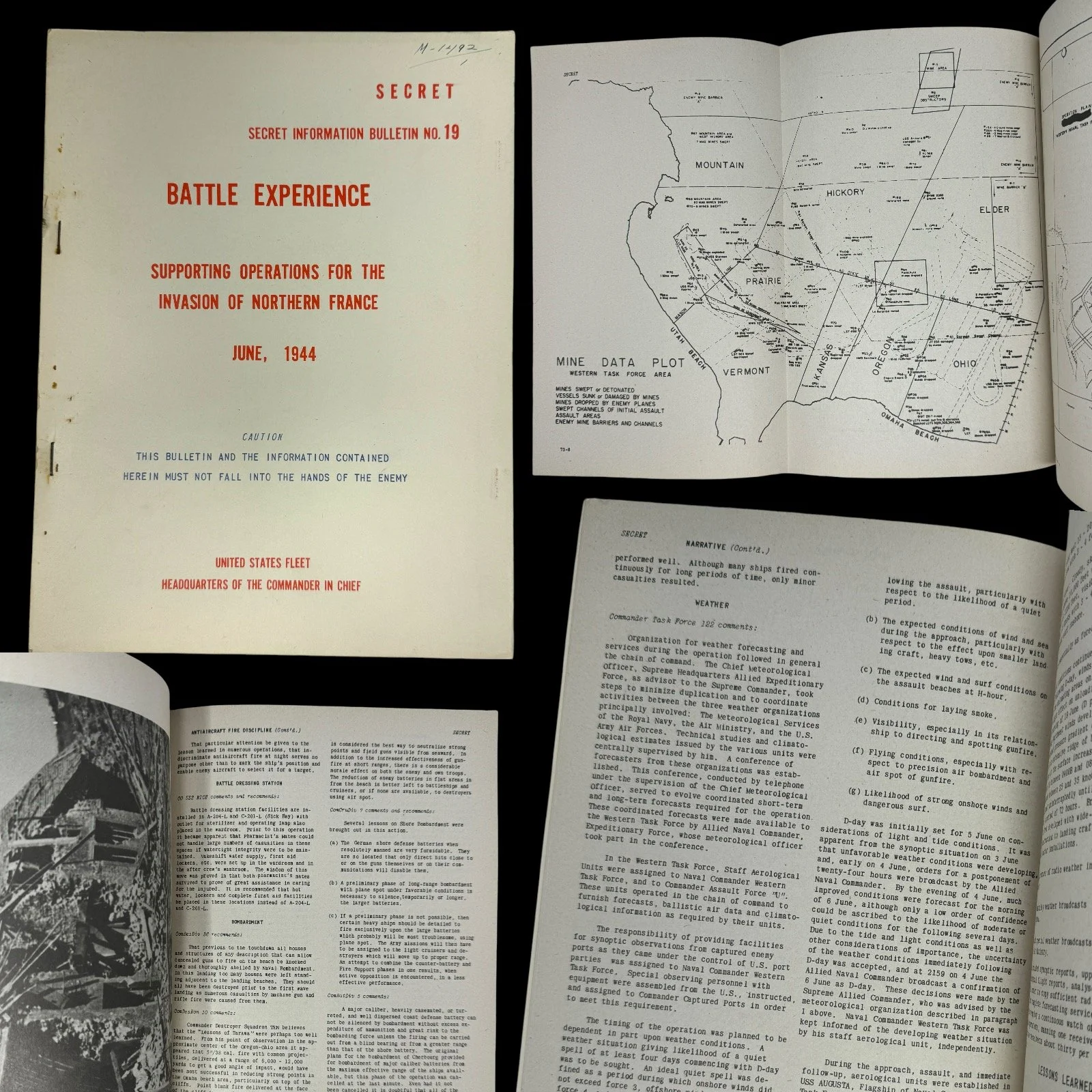
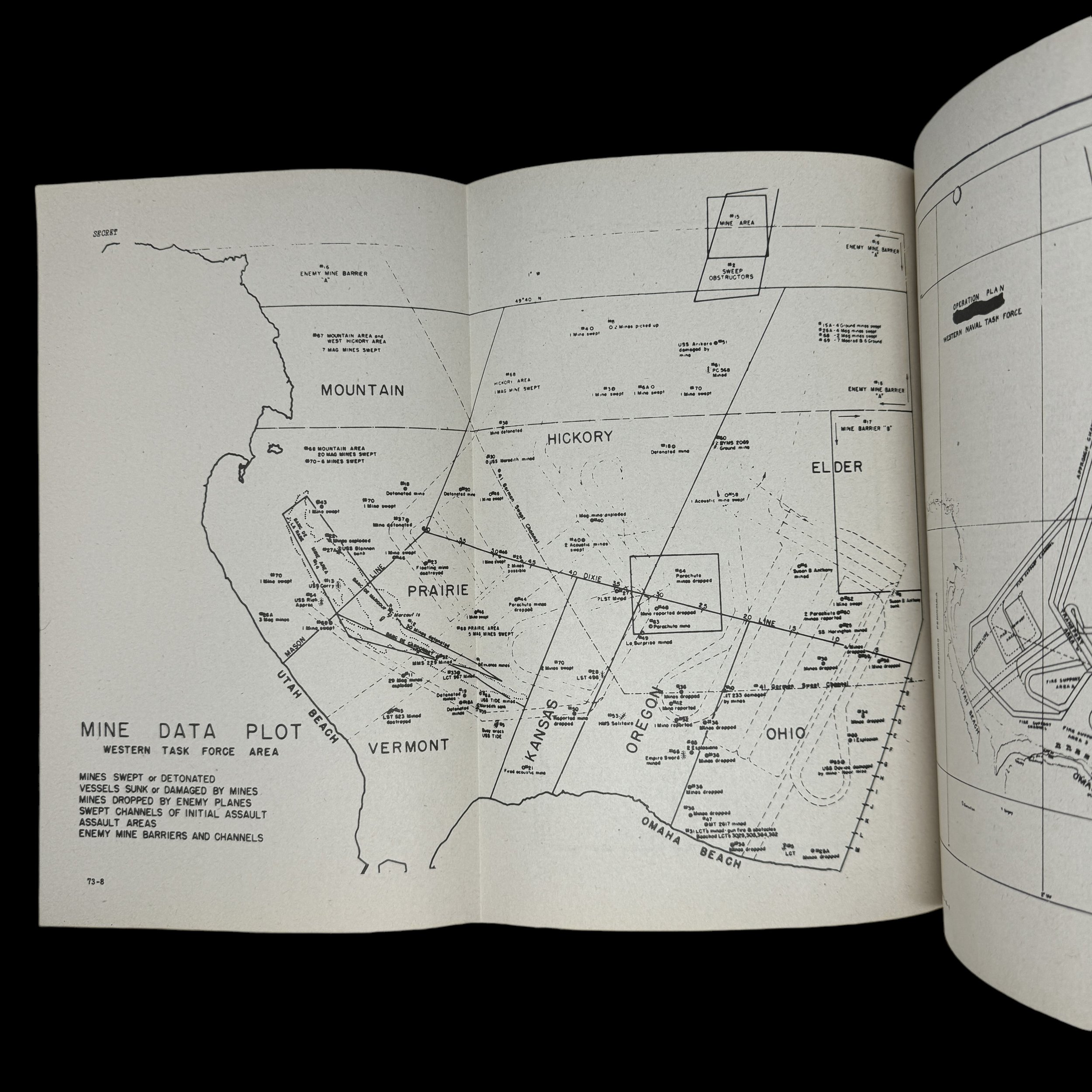
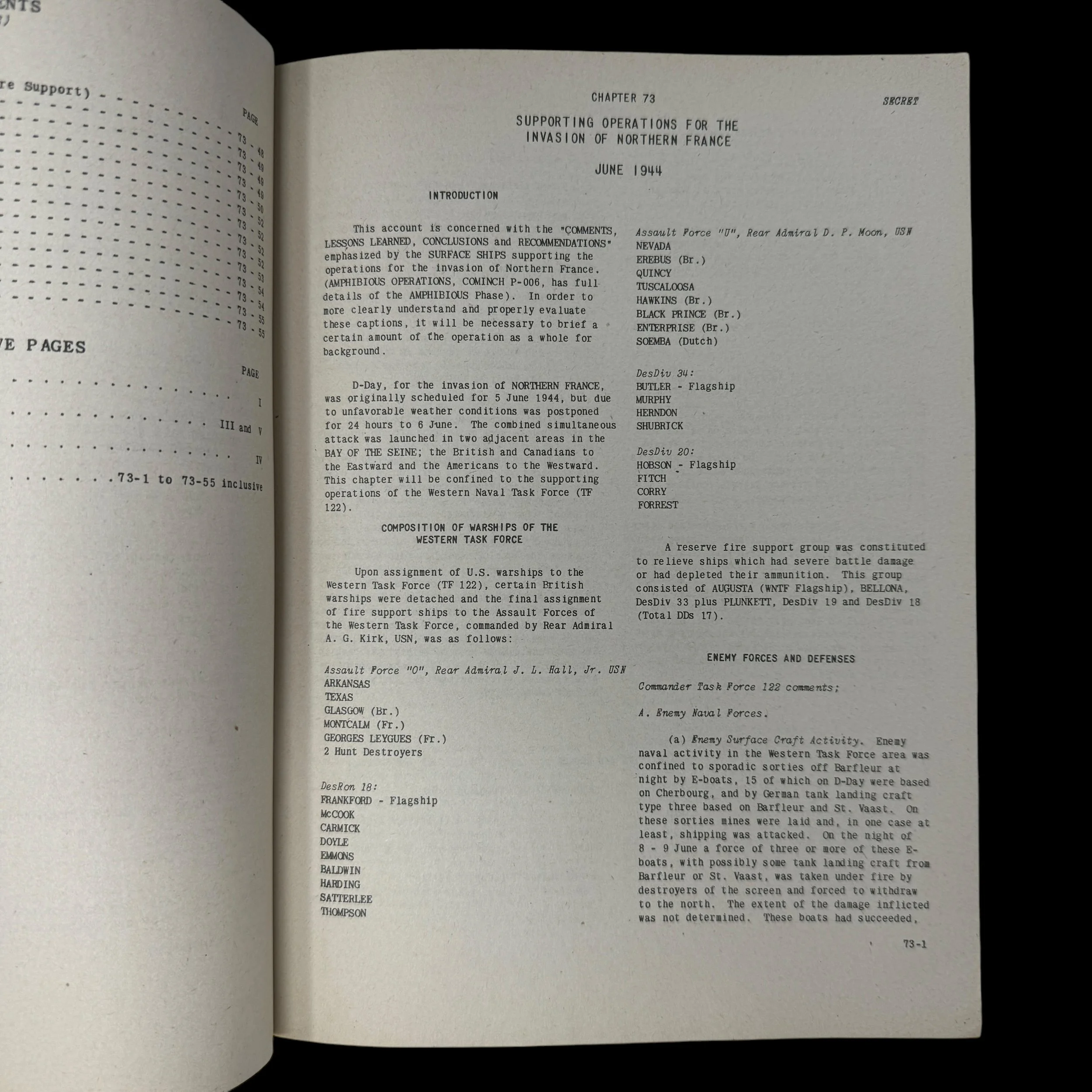
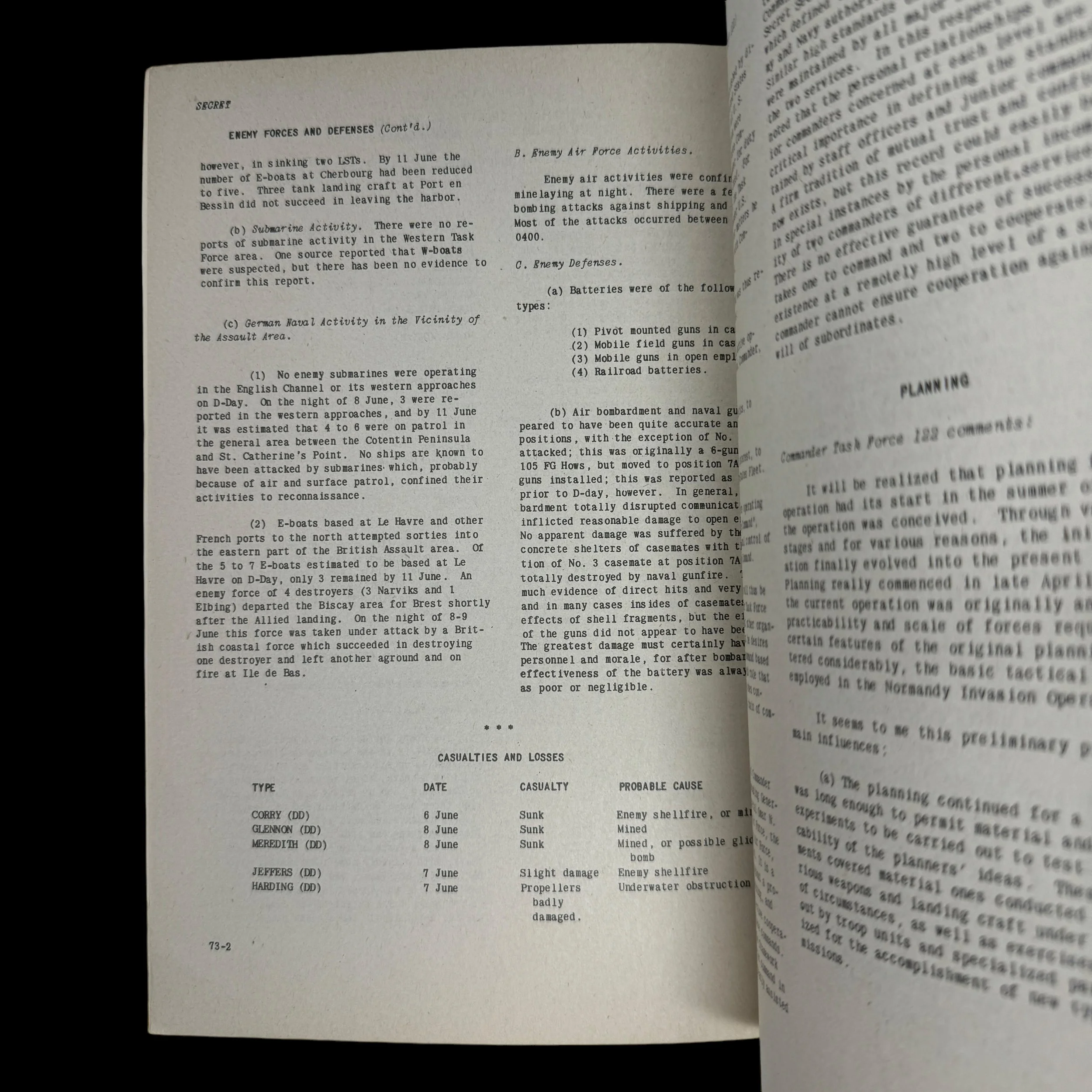
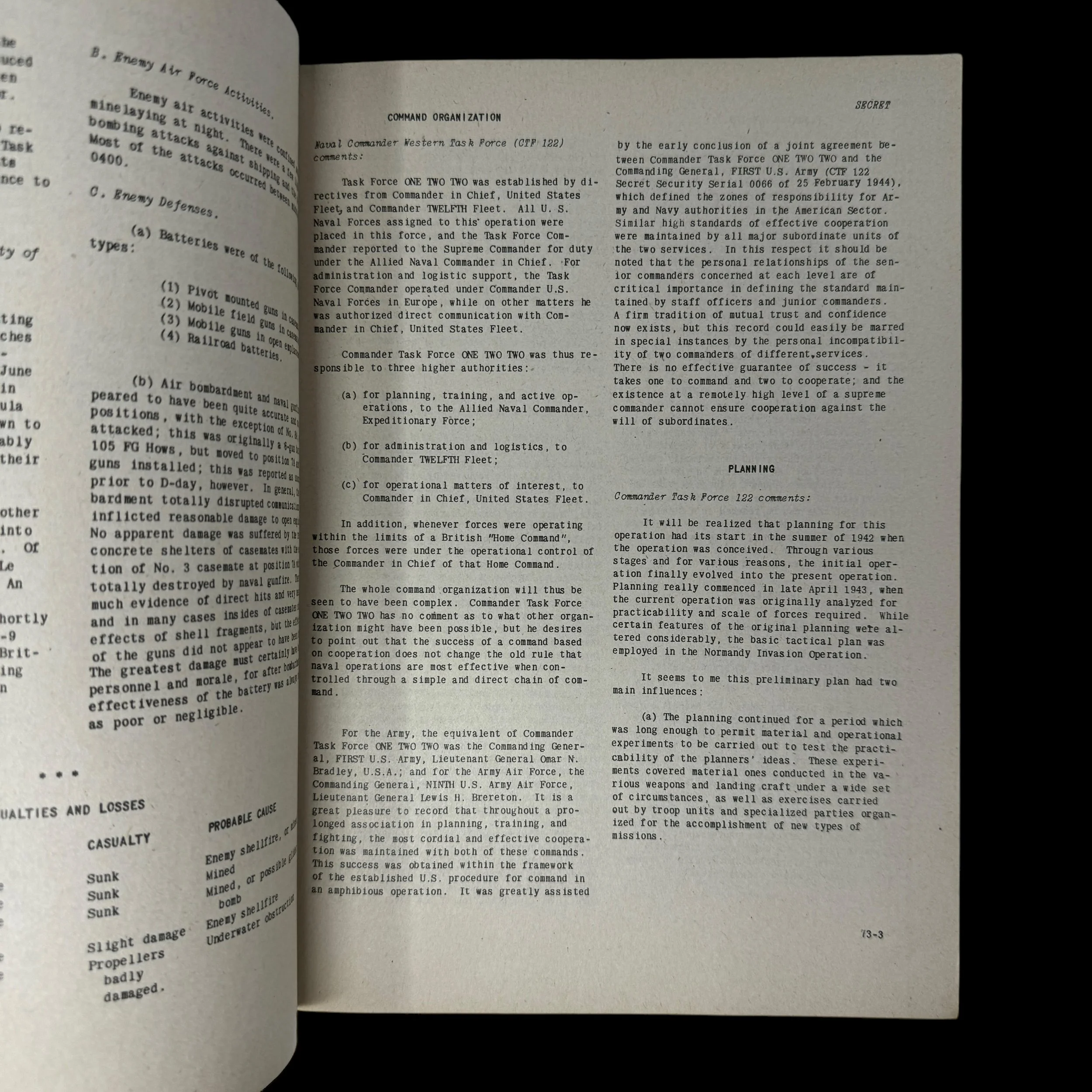
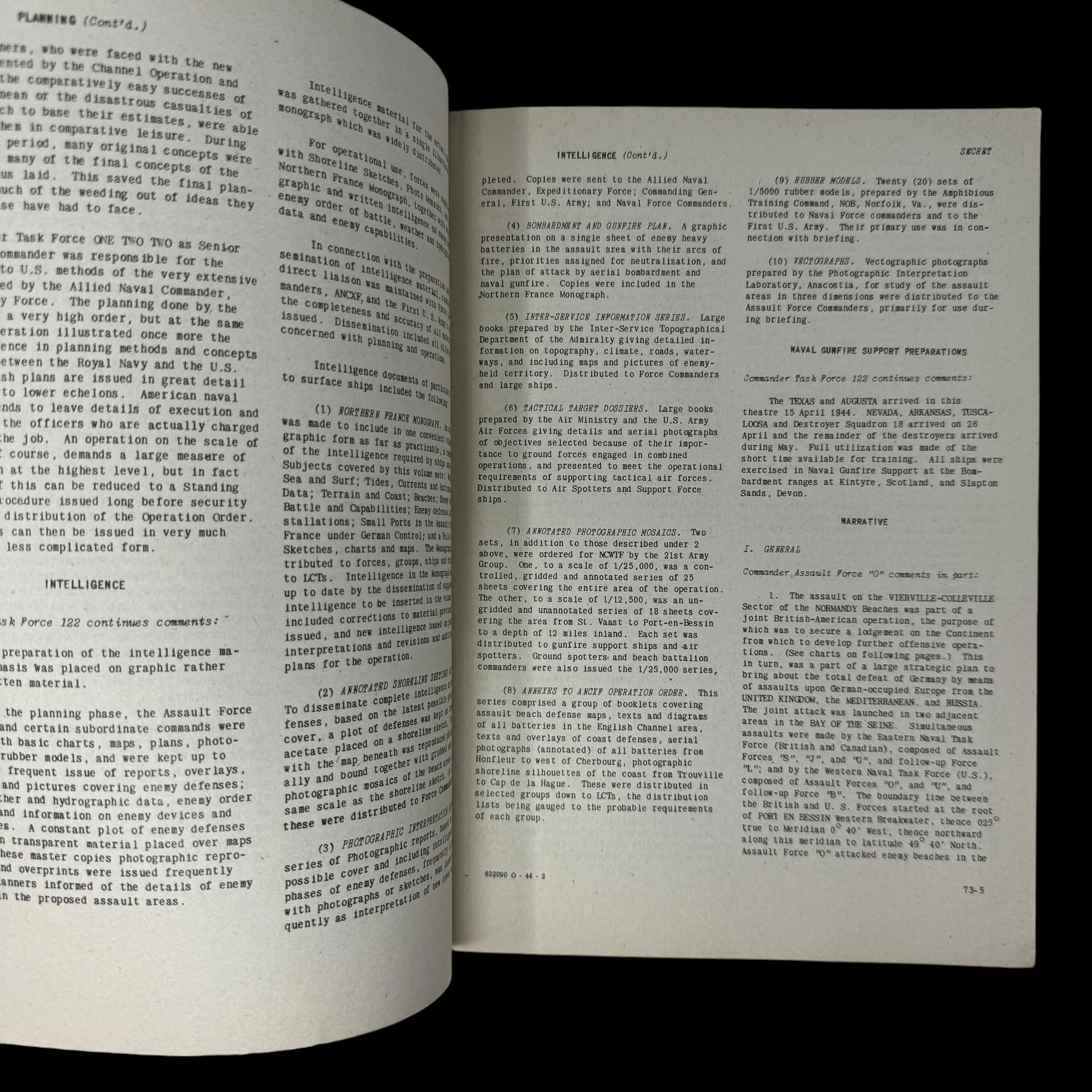
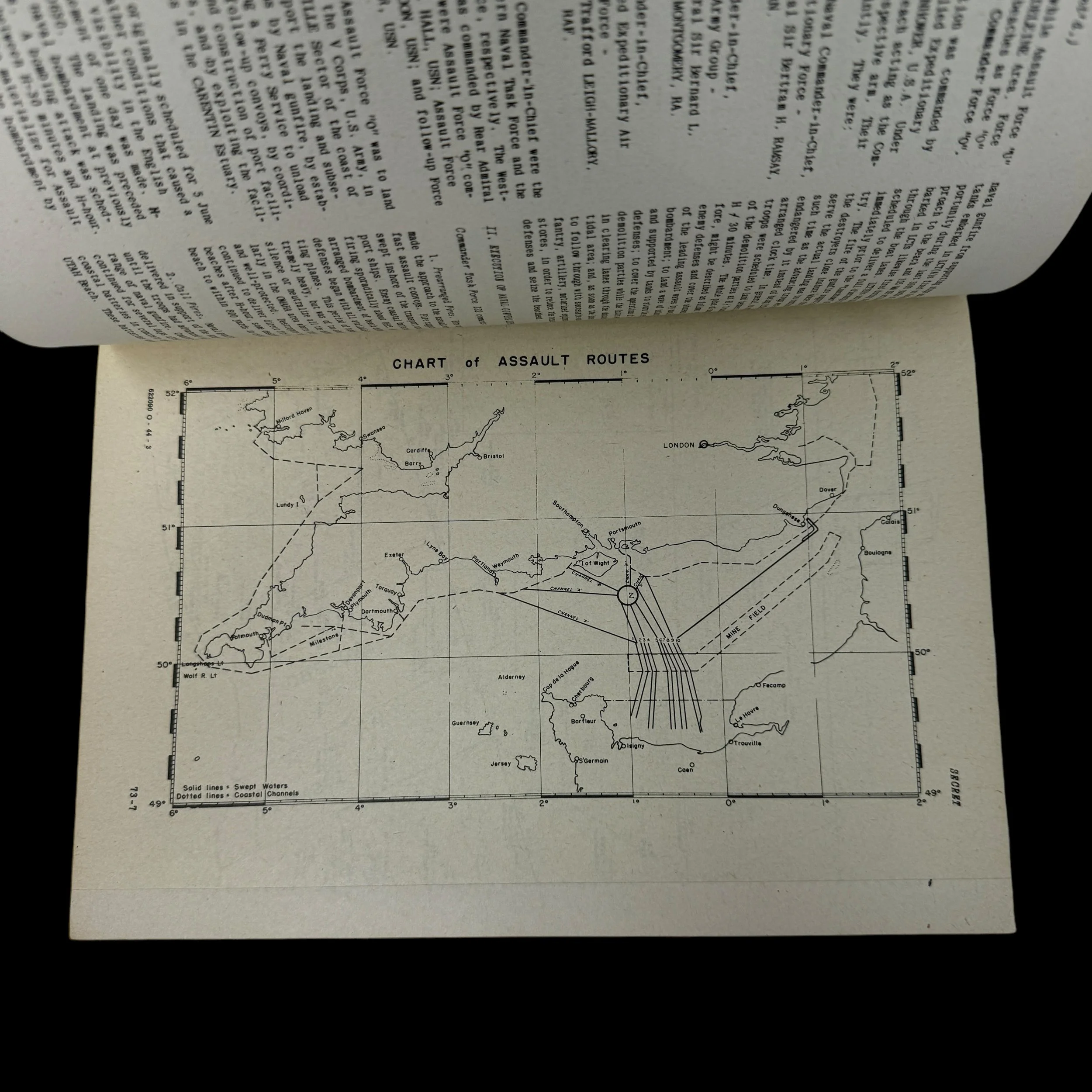
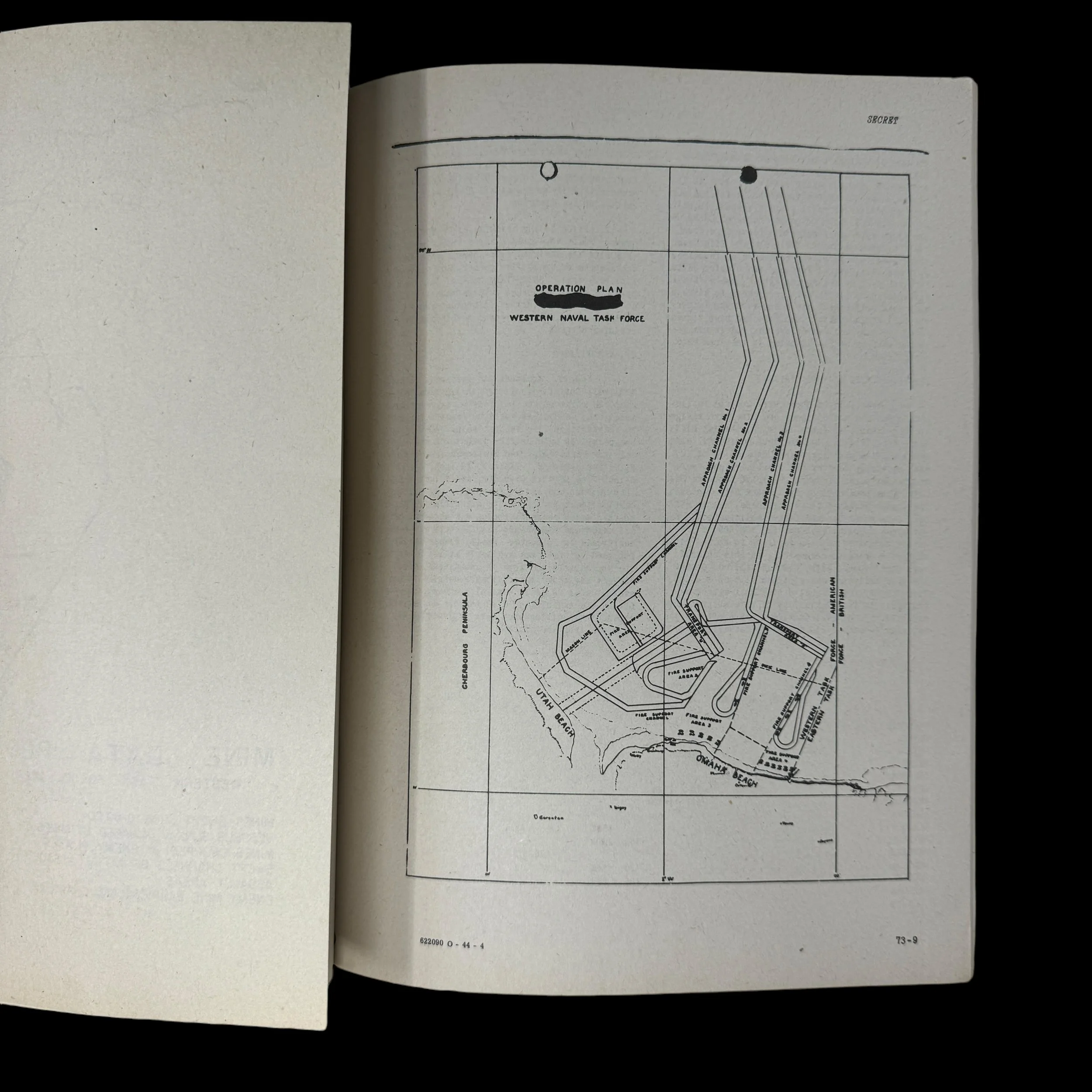
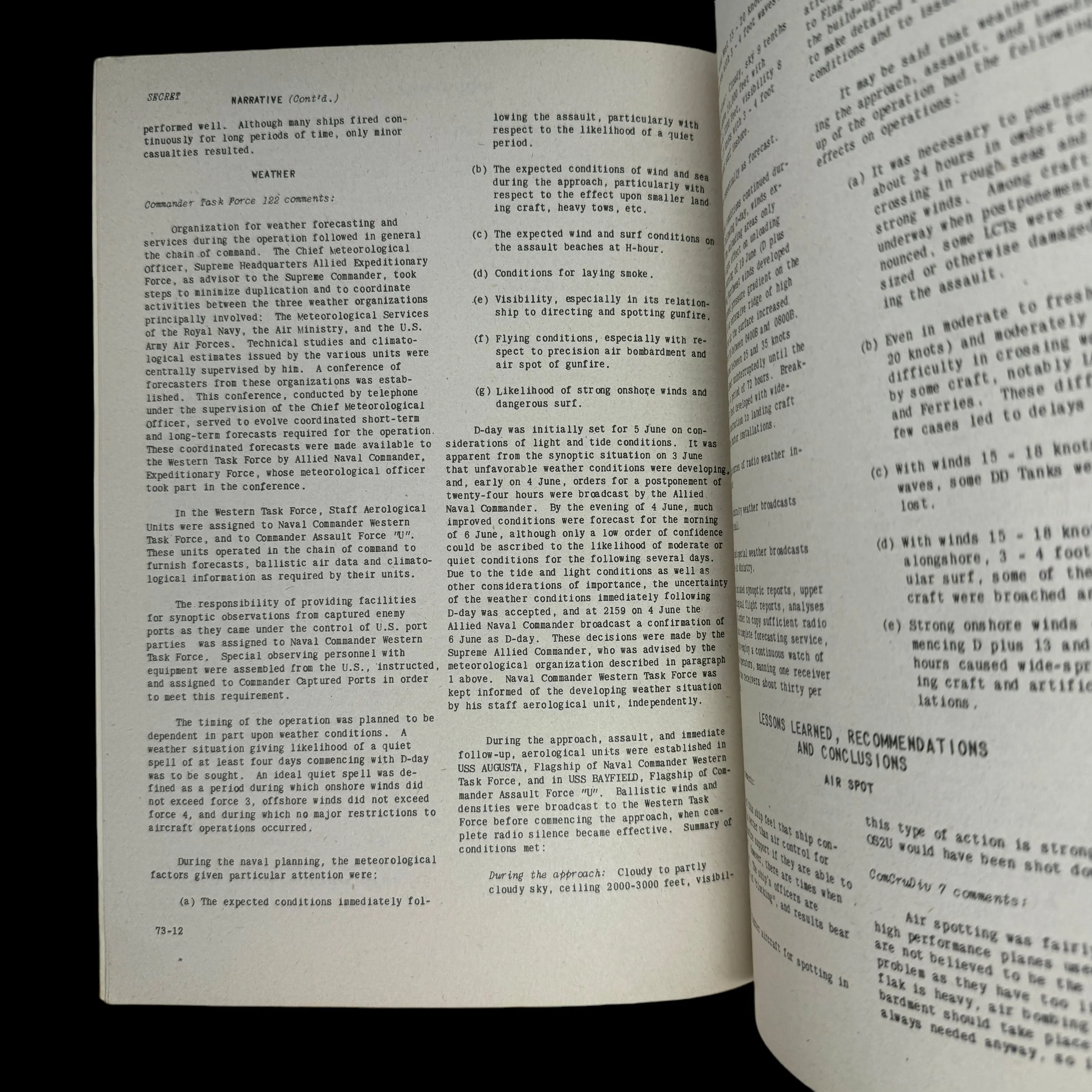

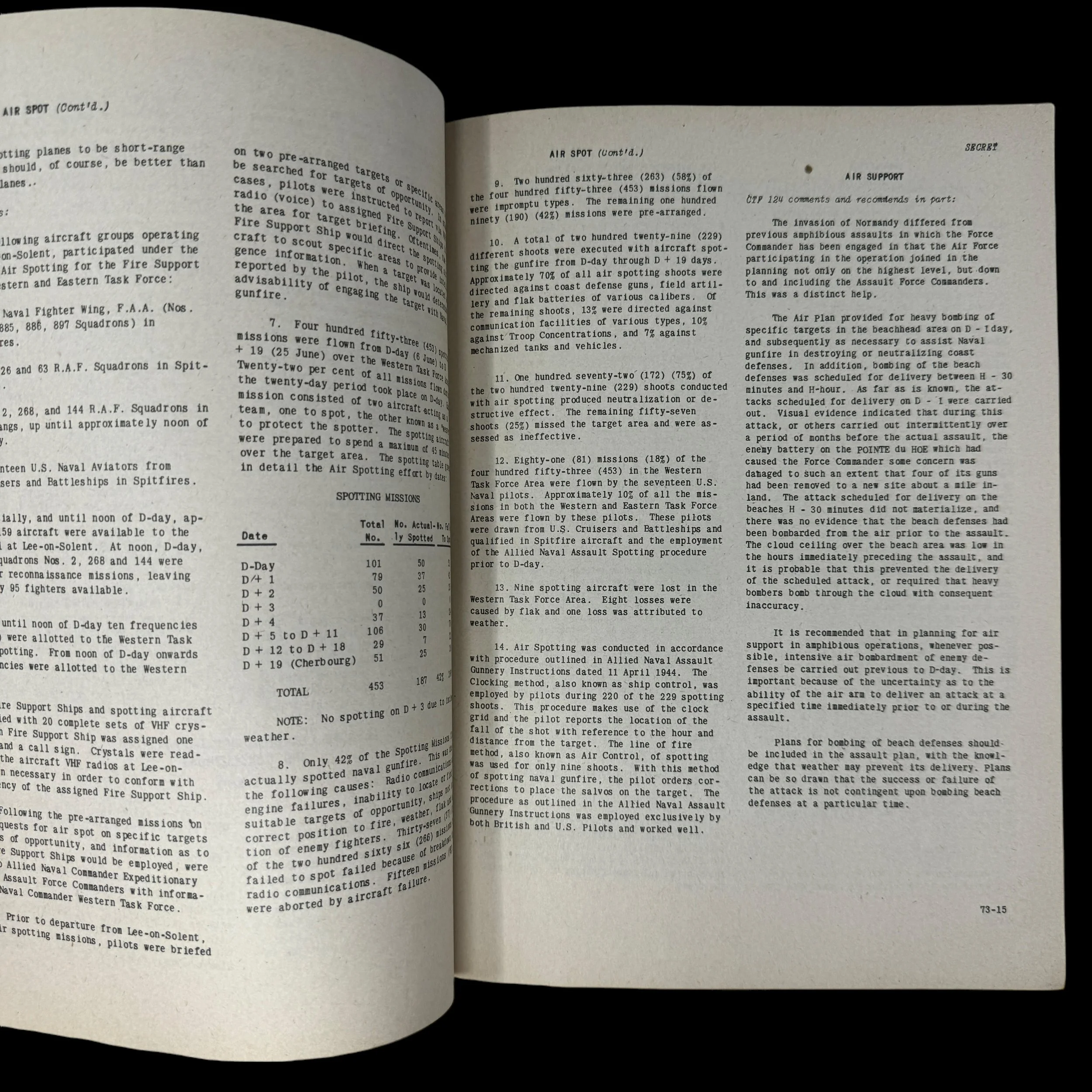
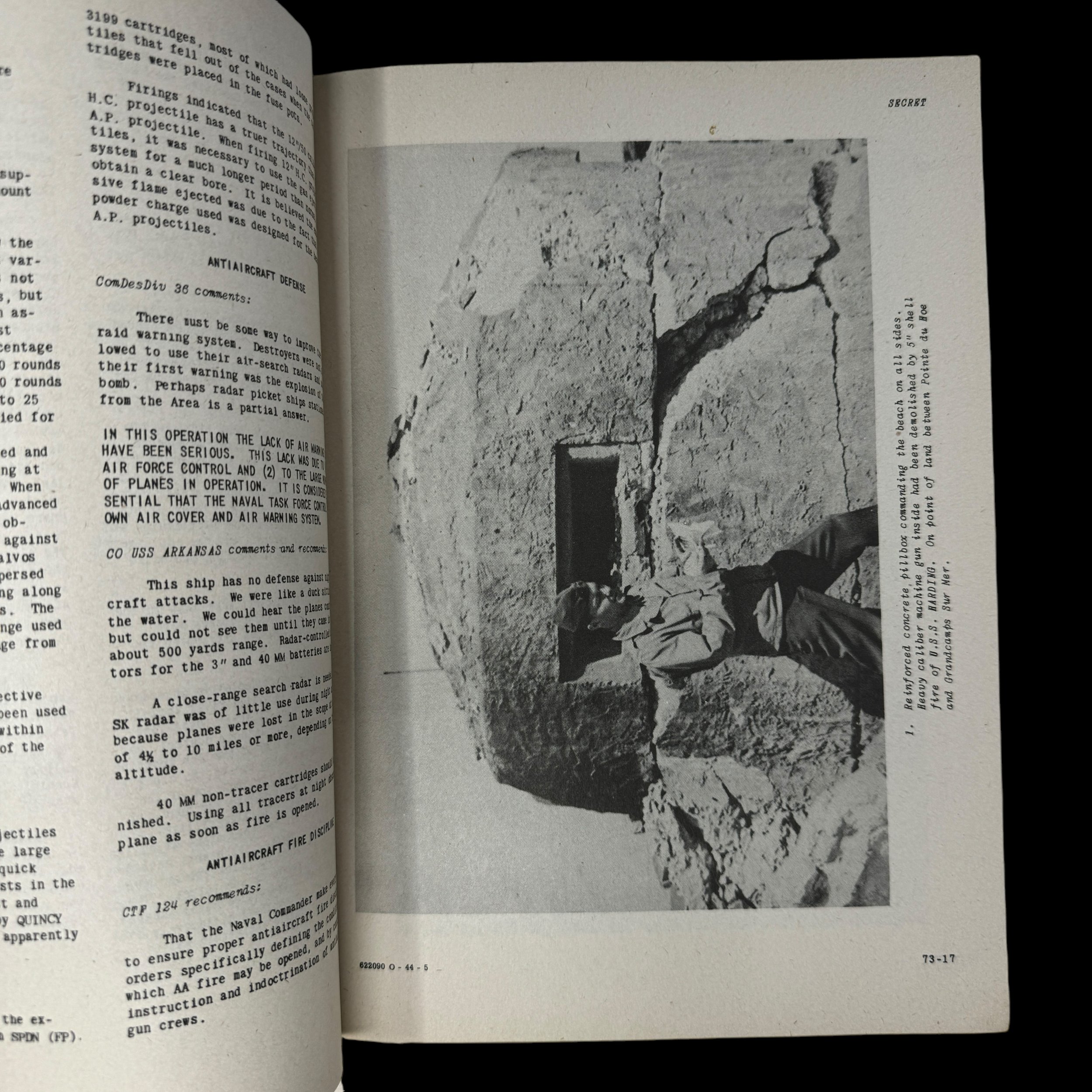




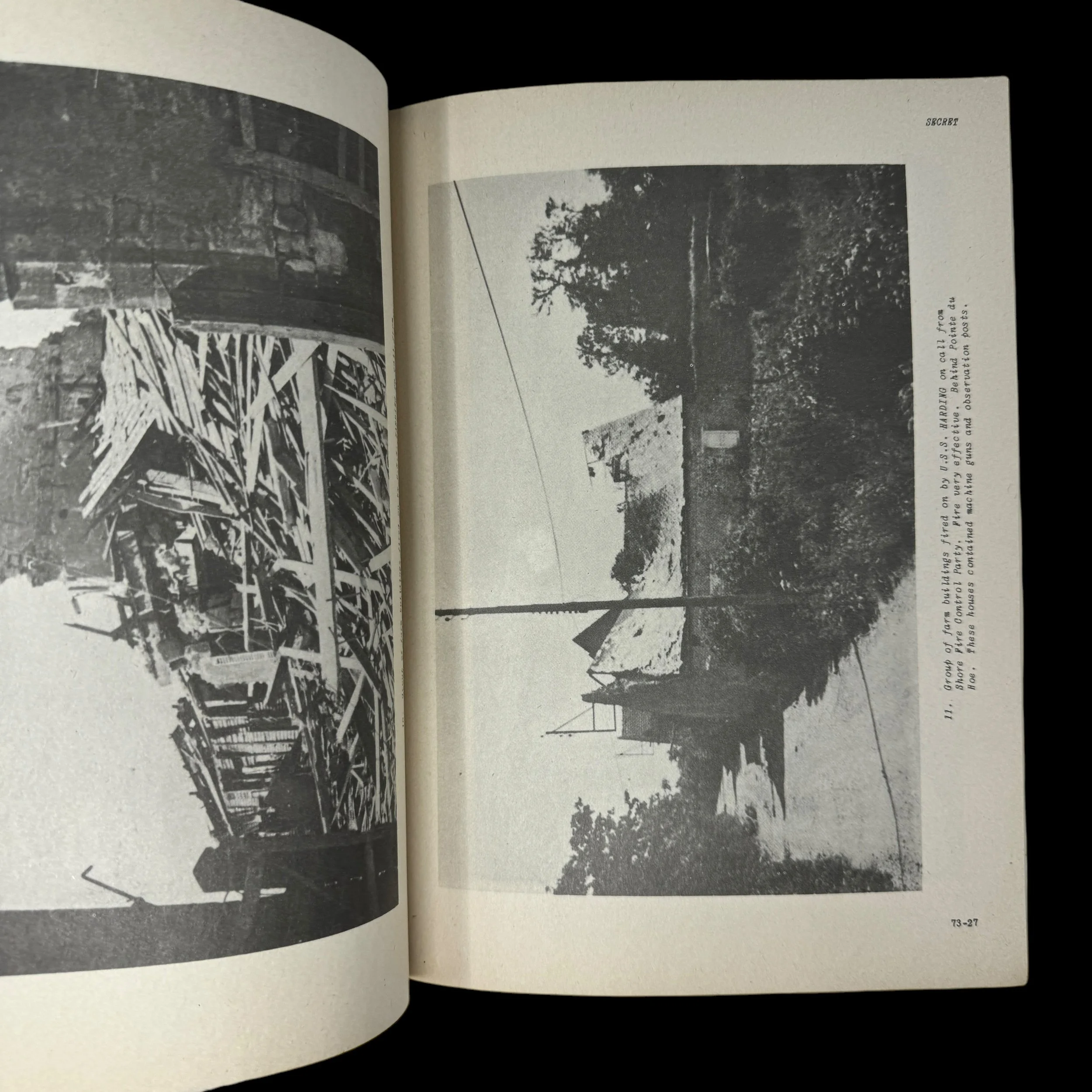
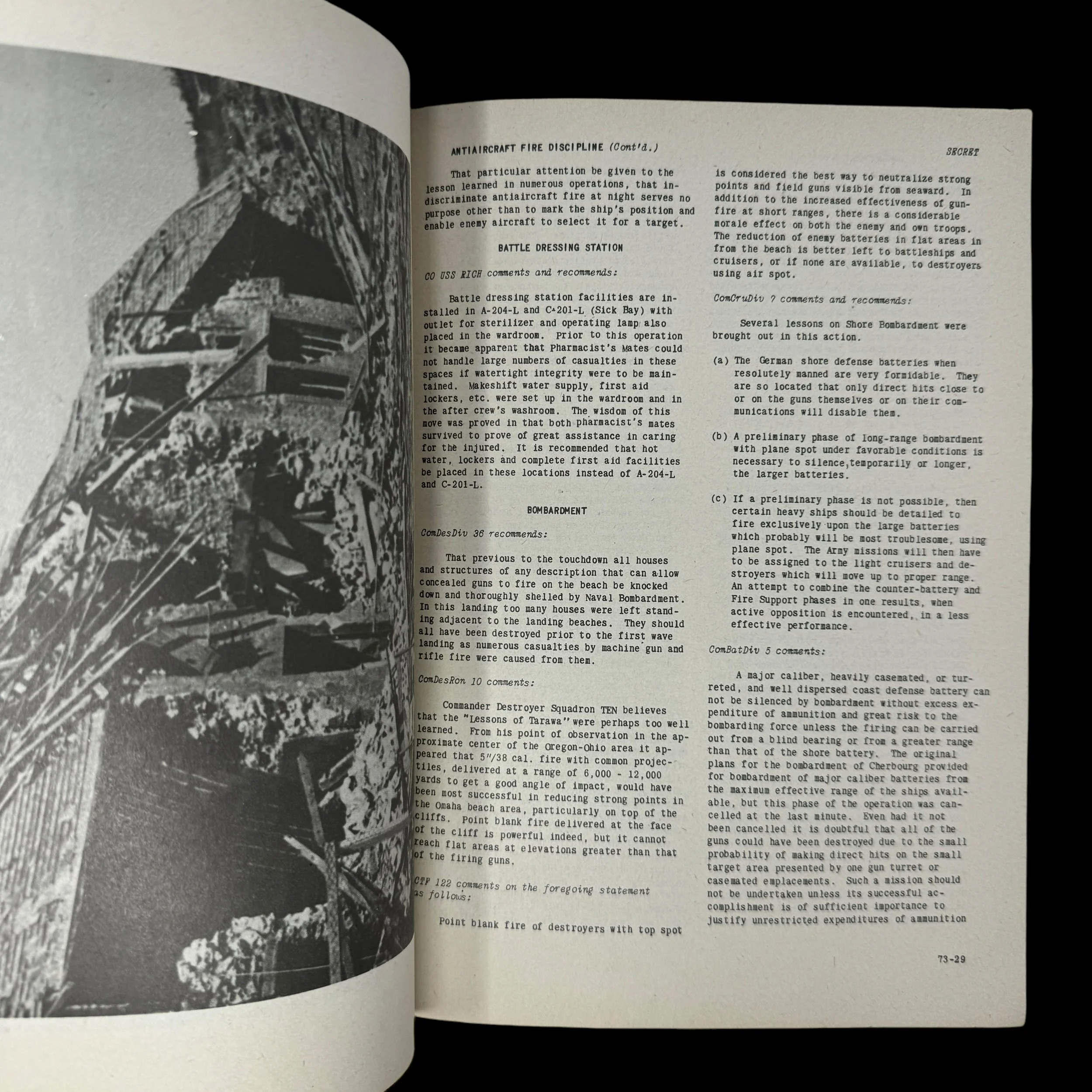
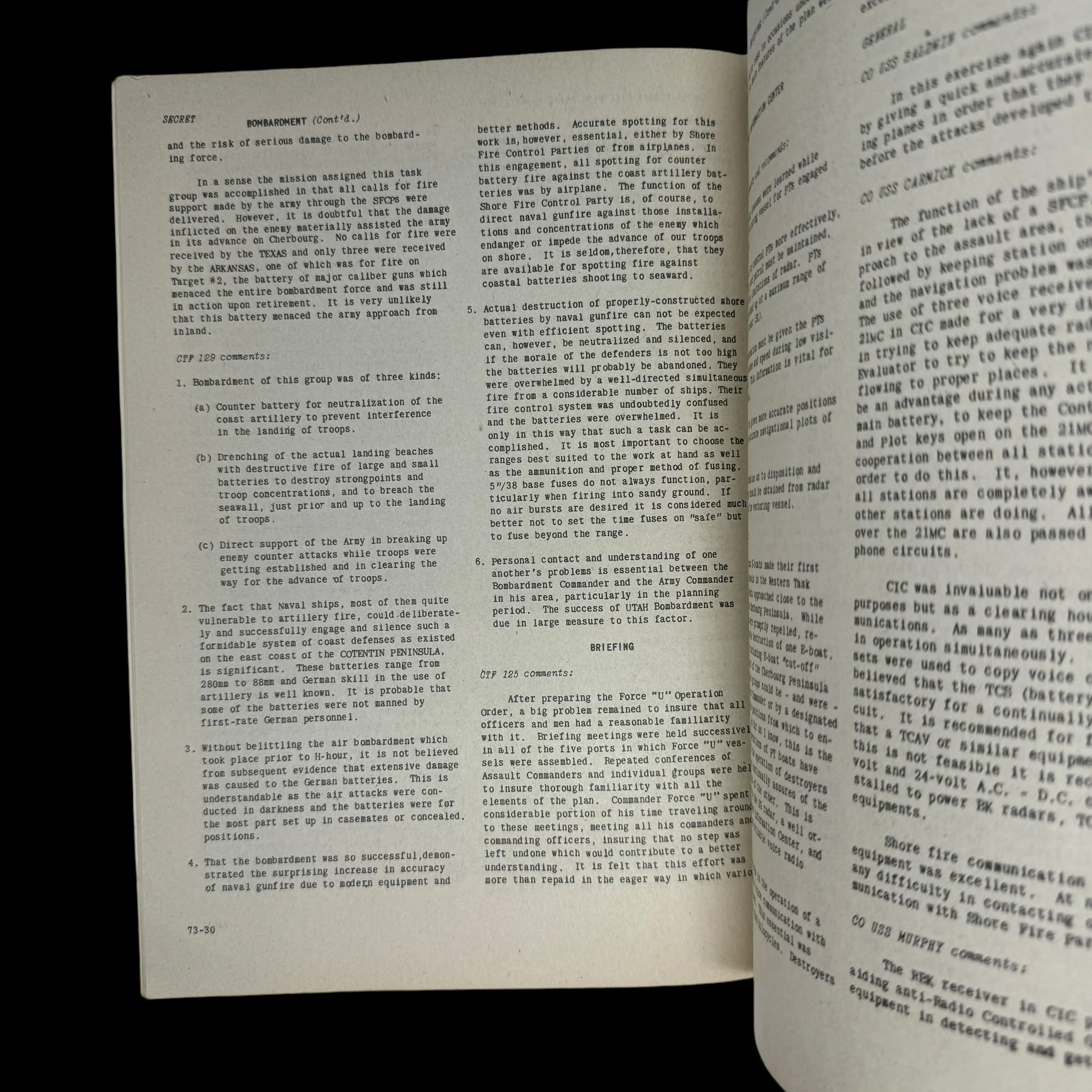
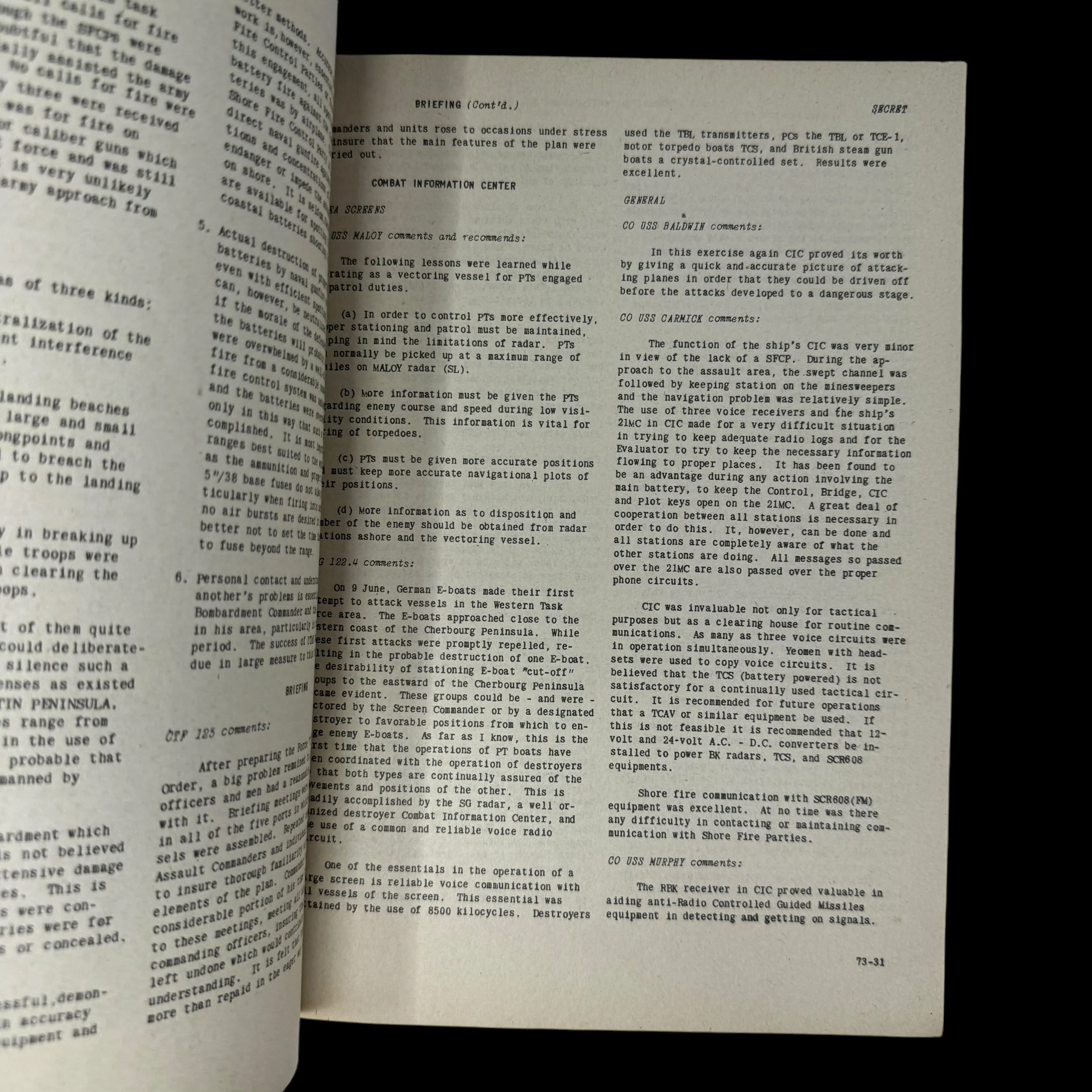

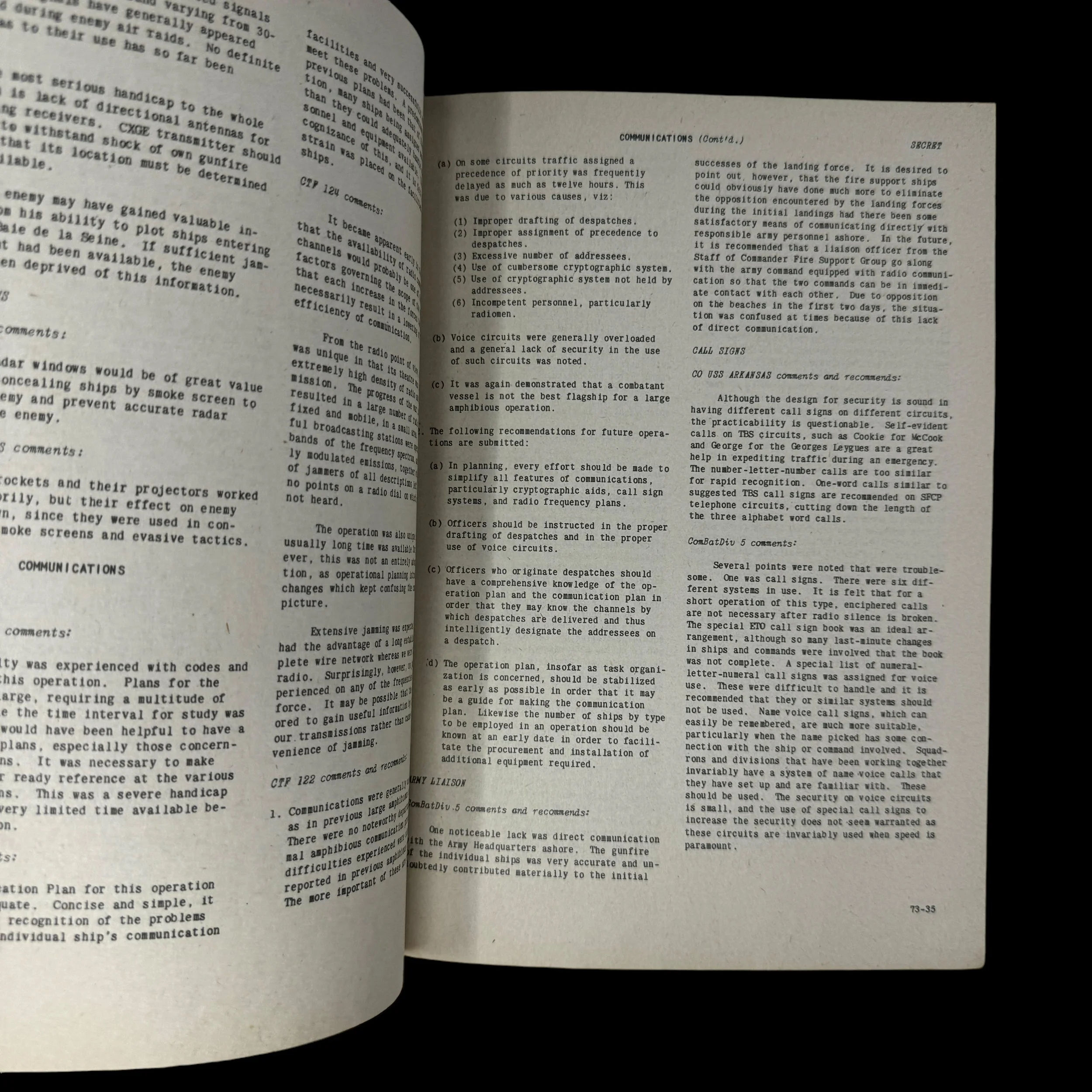
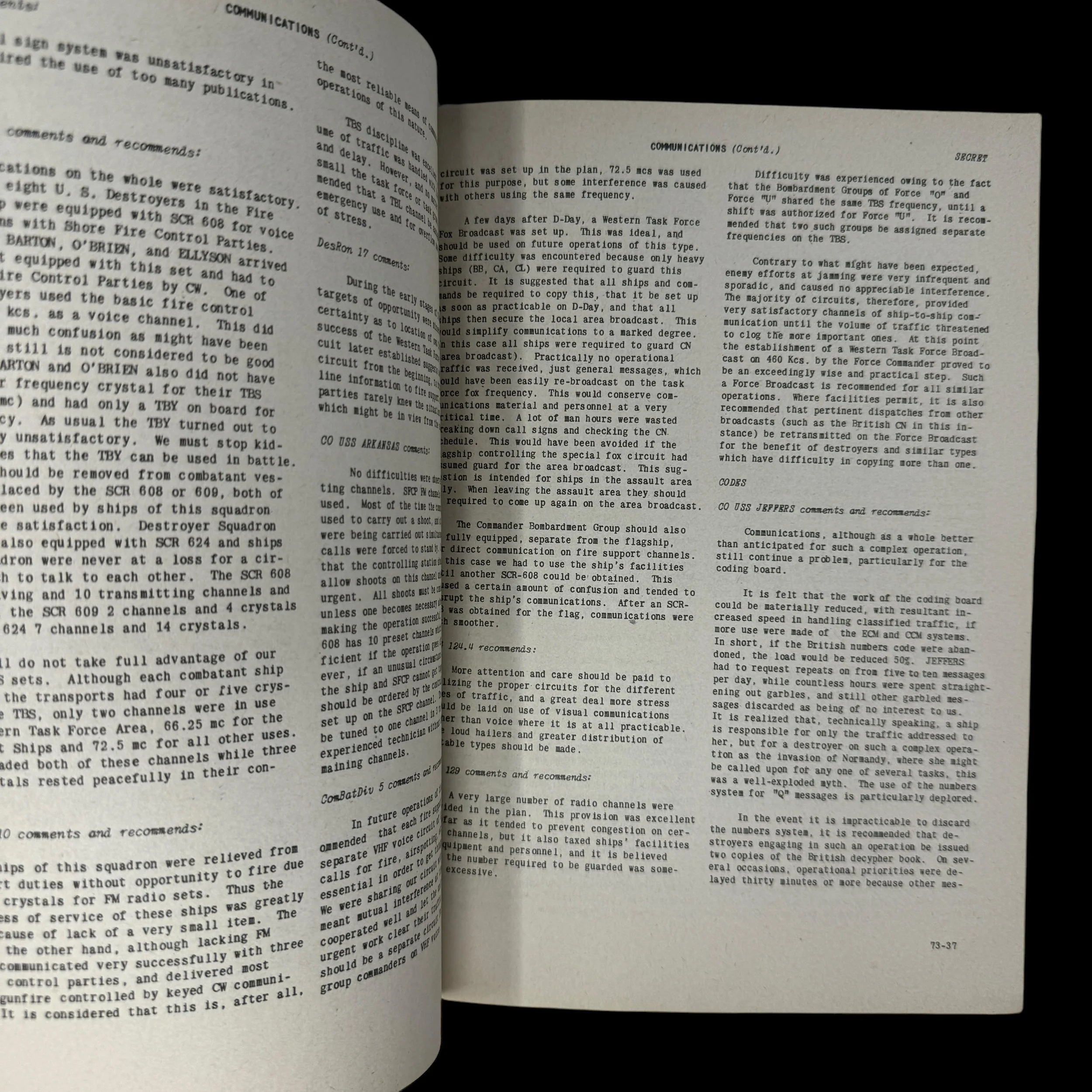
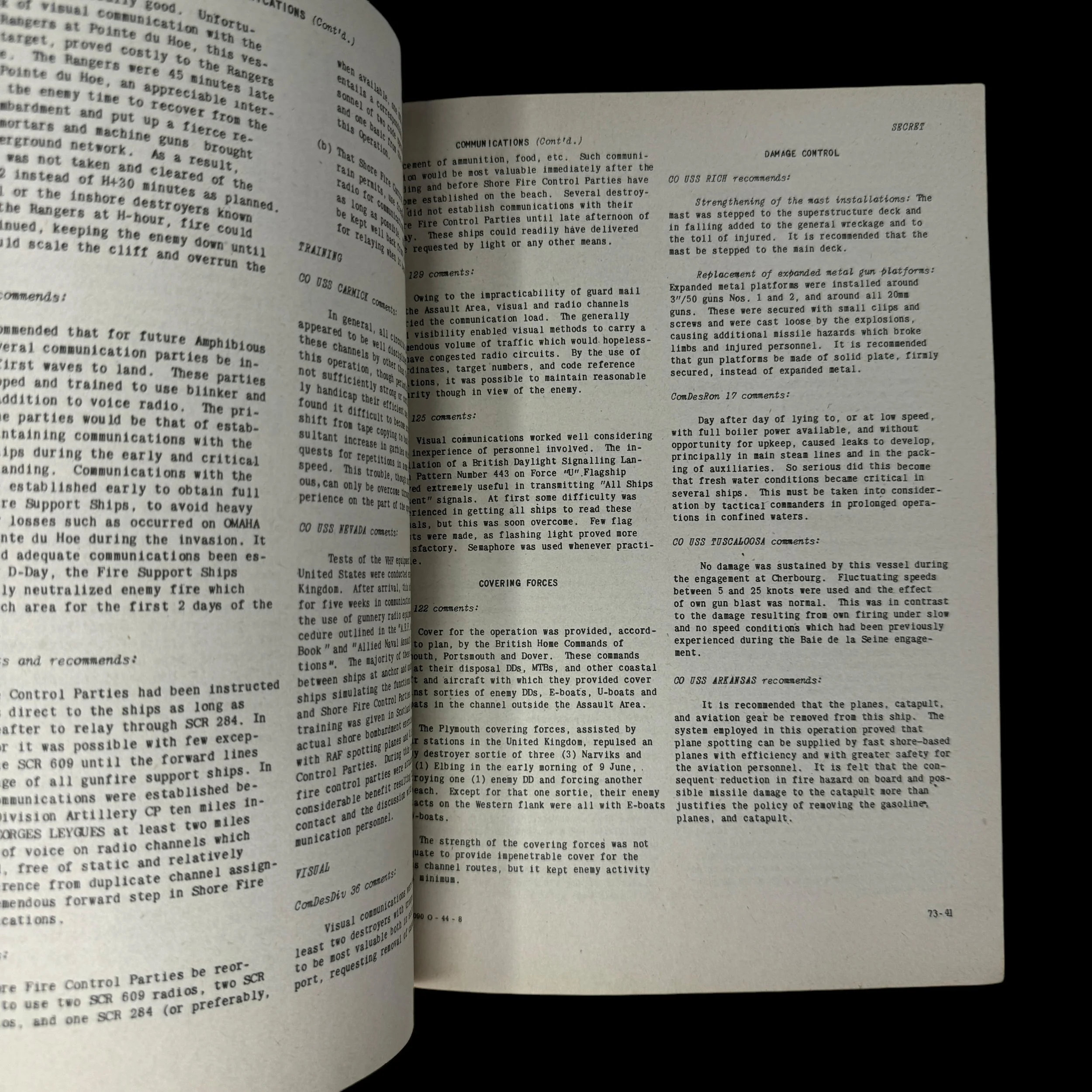
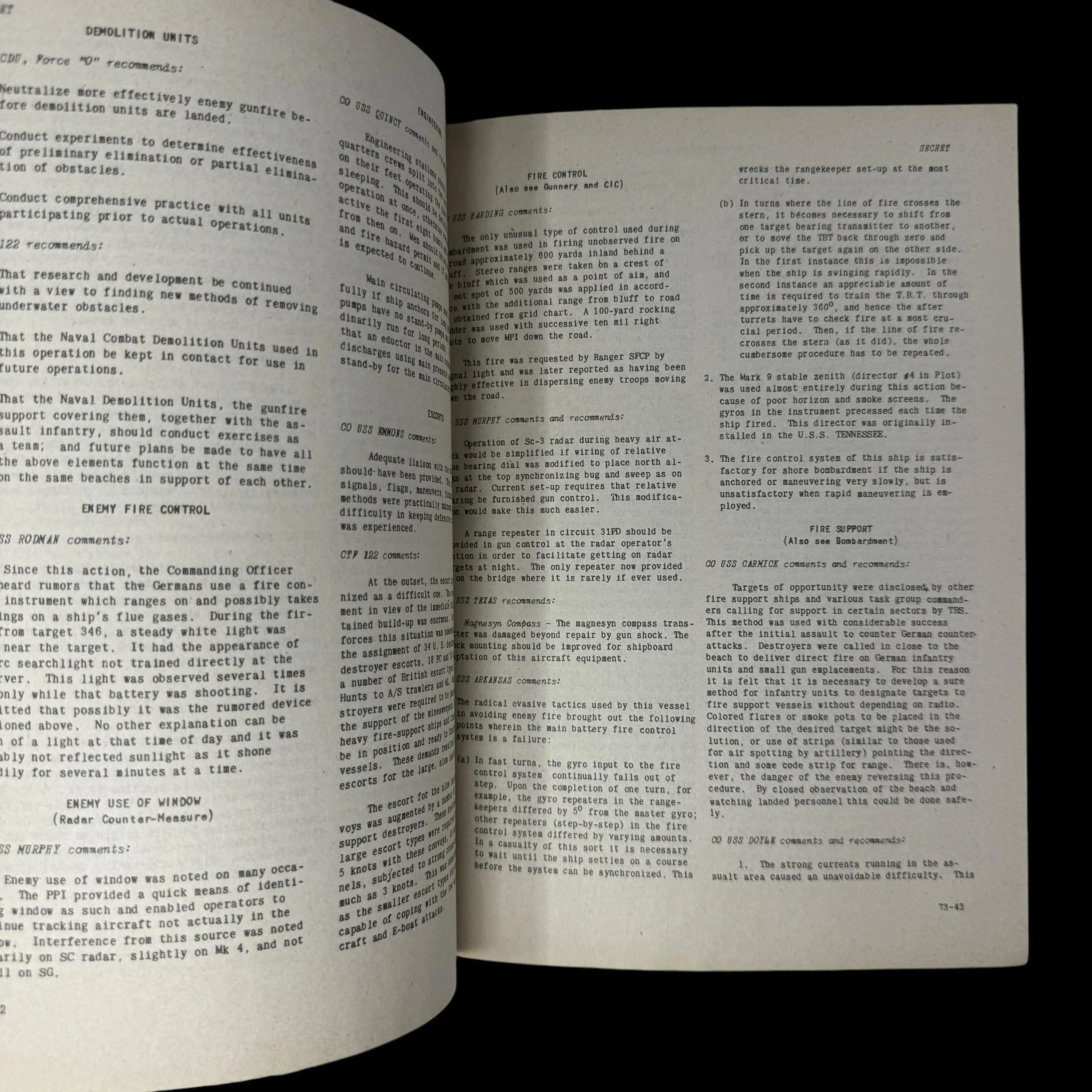
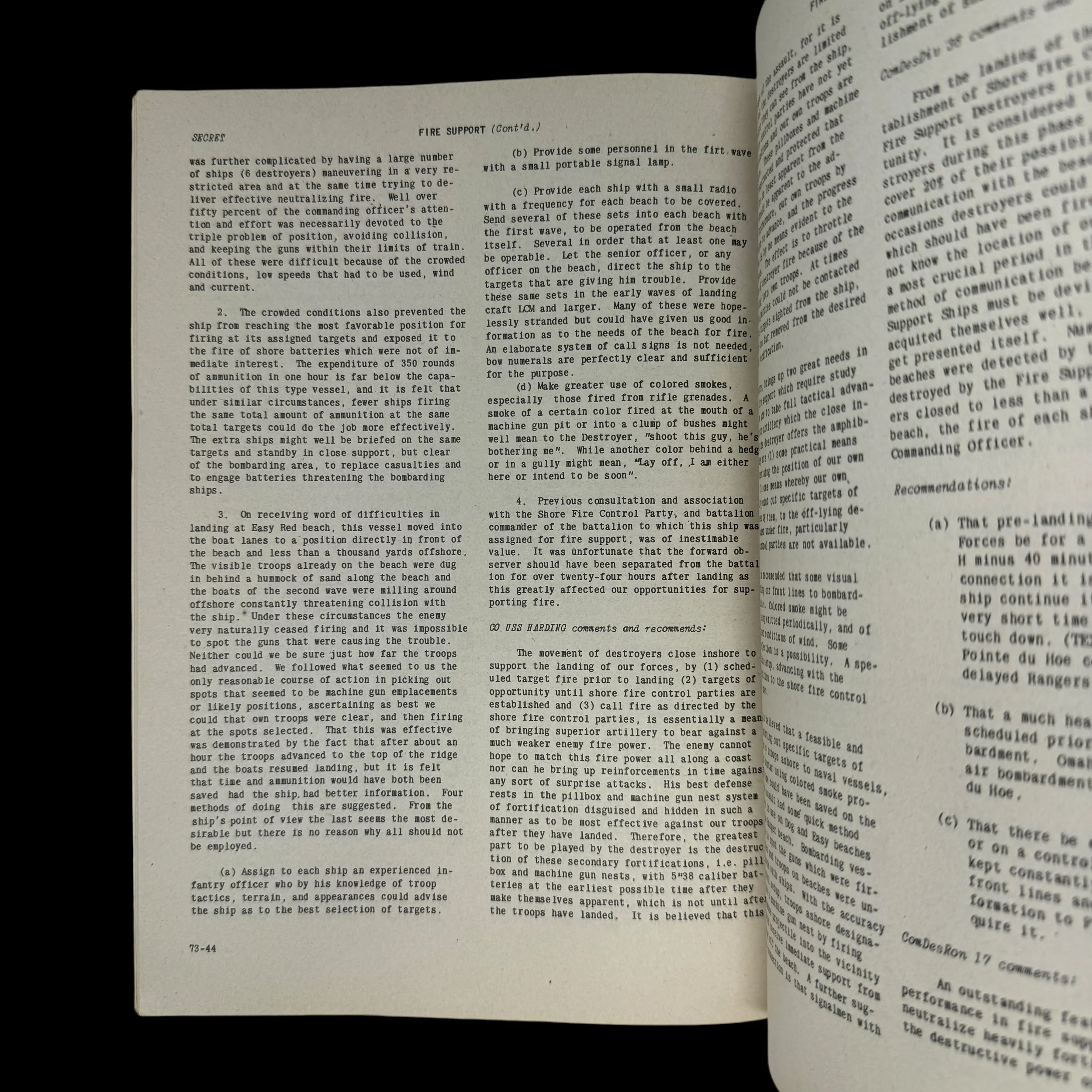
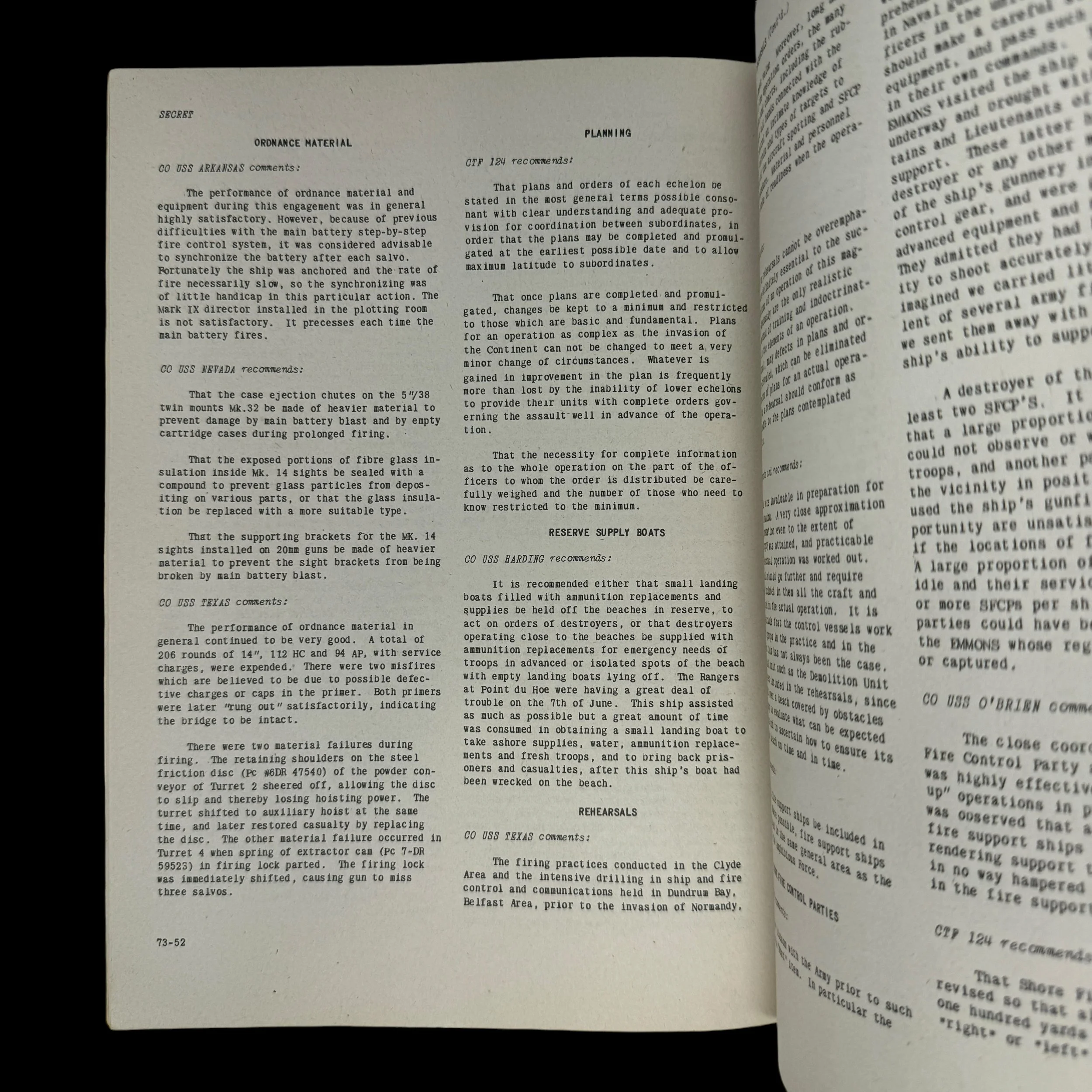
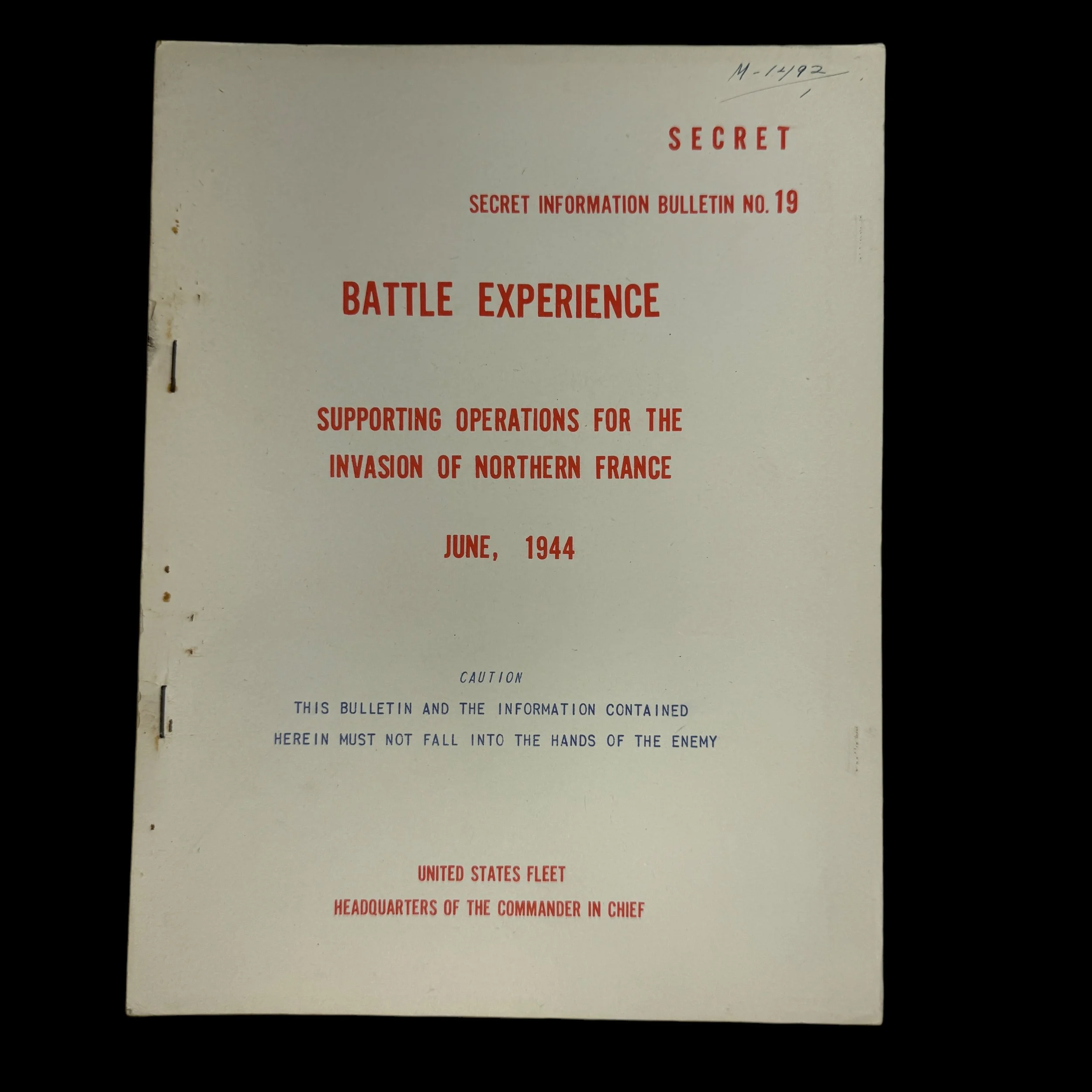
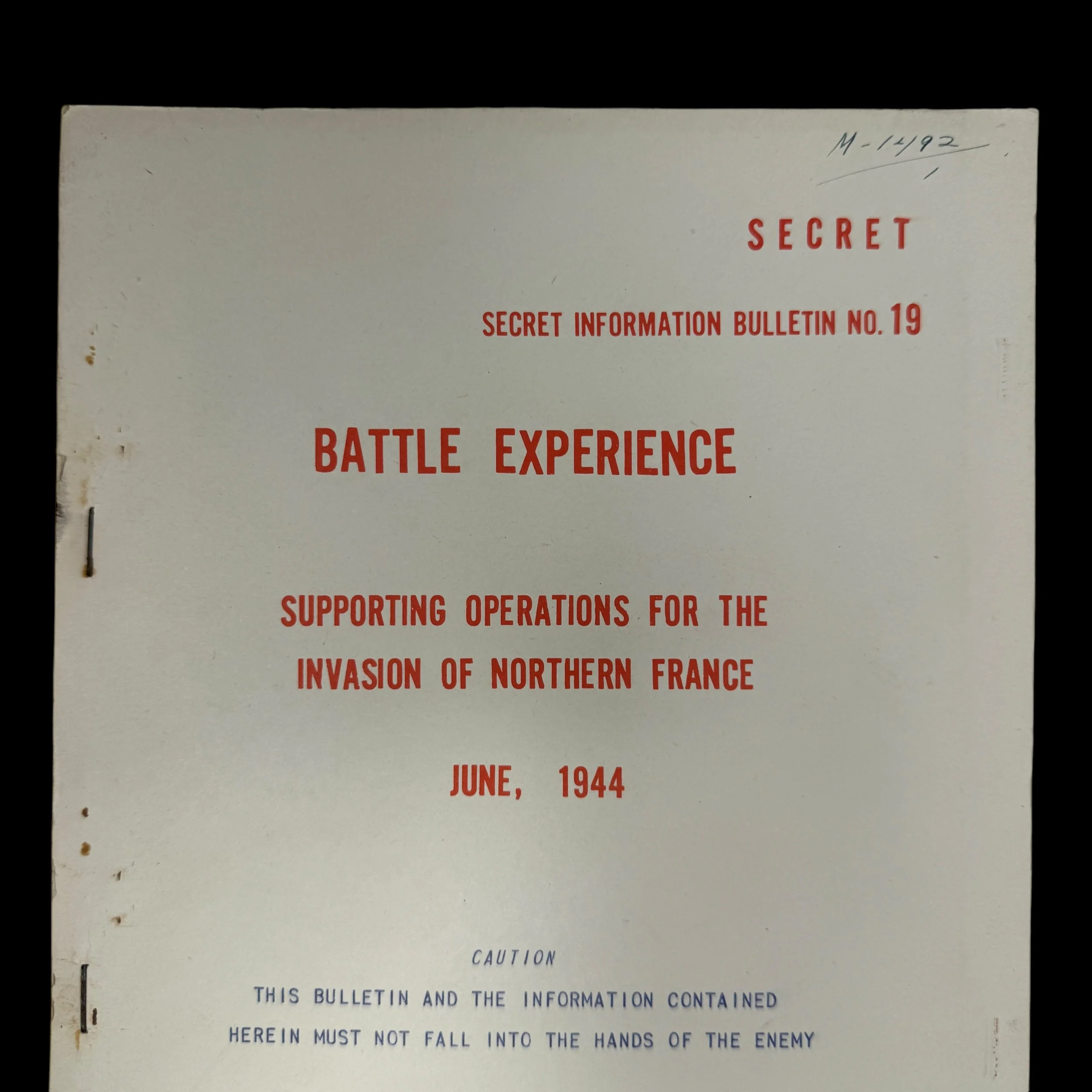
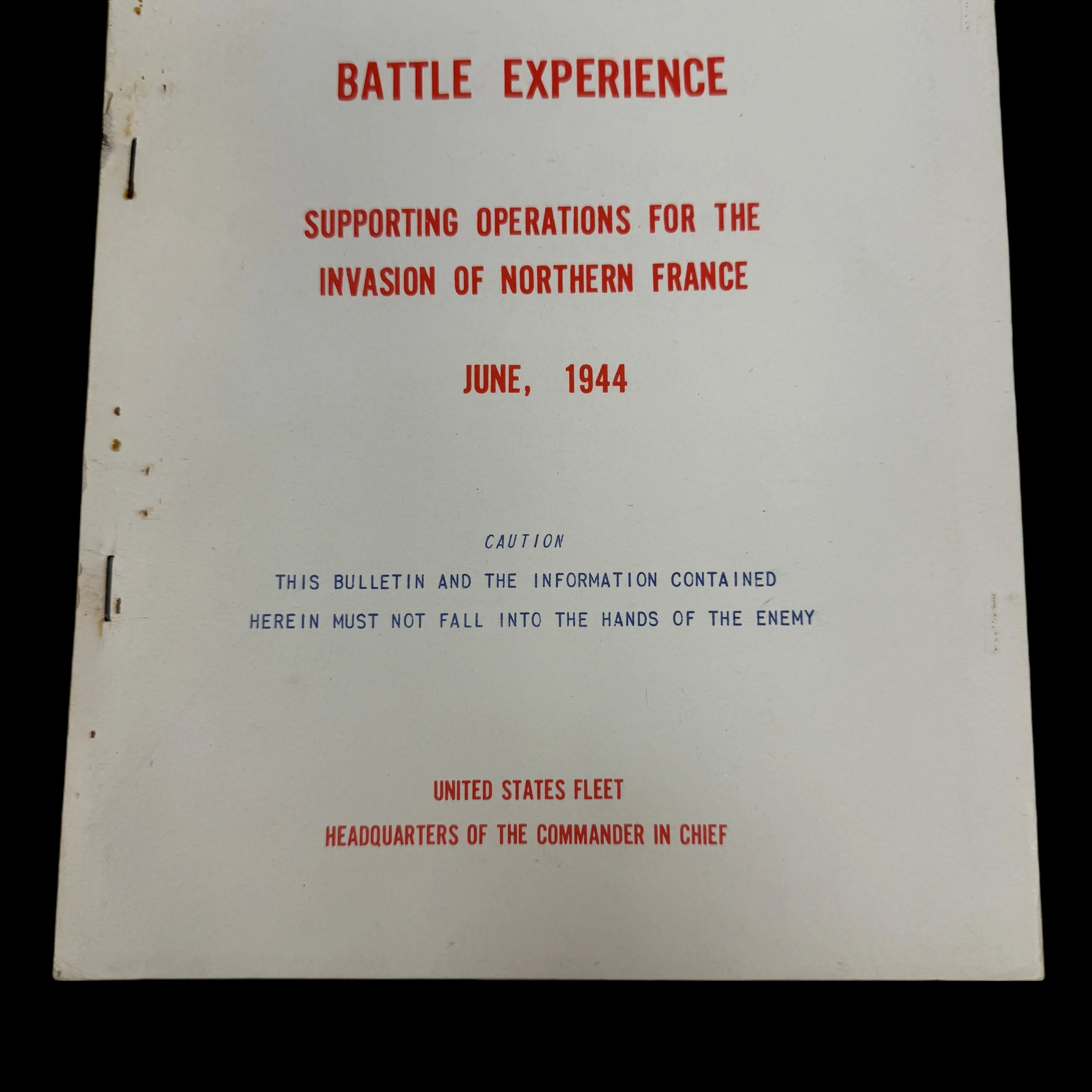
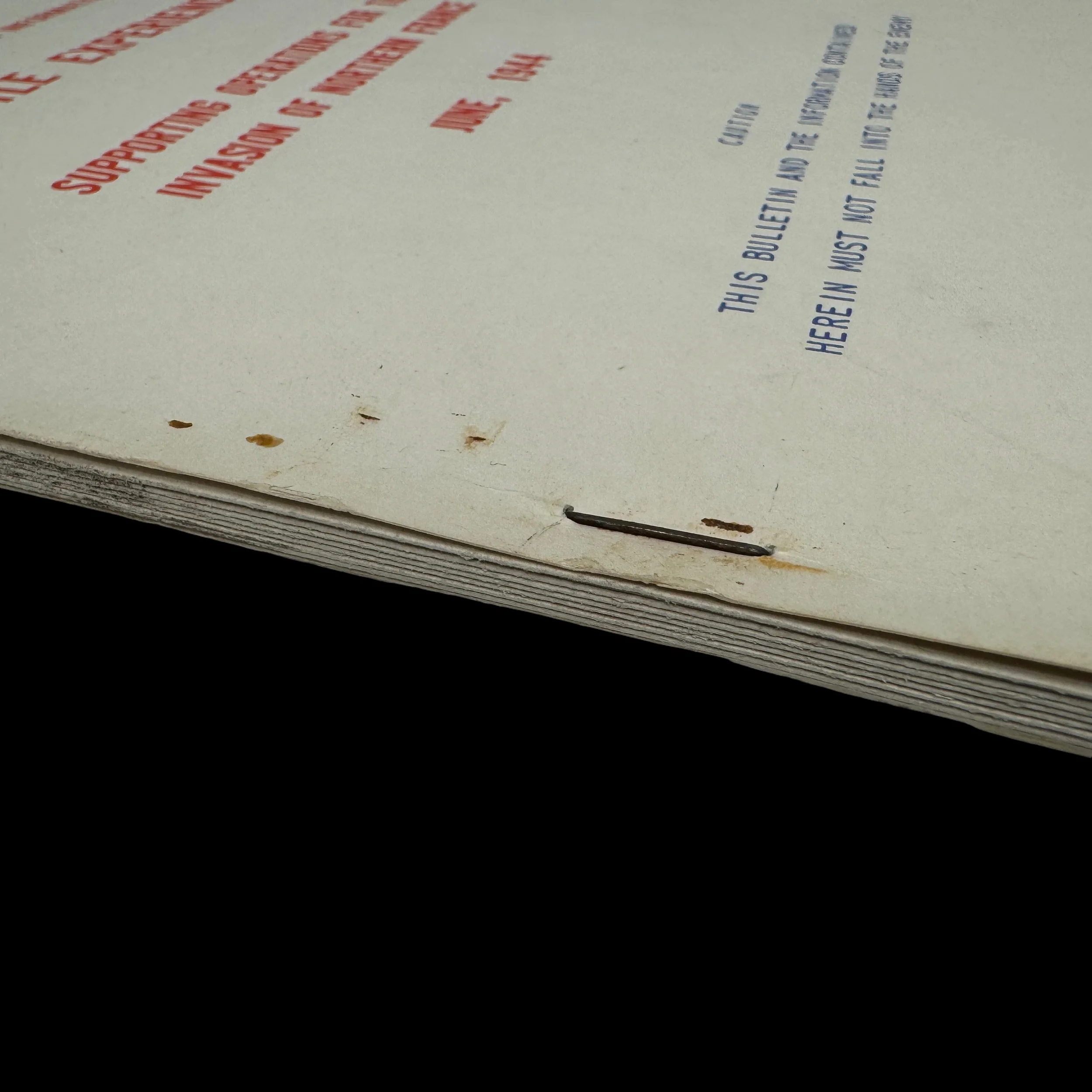
EXTREMELY RARE! WWII SECRET Normandy D-Day 1944 Operation Overlord Headquarters of the Commander in Chief Military Intelligence Report
Comes with a hand-signed C.O.A.
*This confidential intelligence report details D-Day military intelligence on German naval, air force, and beachhead defenses. It includes insights from Commander Task Force 112, Assault Force "O," covering topics such as naval fire support, weather conditions, lessons learned, operation comments of the USS Arkansas & USS Nevada spotting missions, anti-aircraft offenses, bombardment strategies, and more.
This extraordinarily rare, museum-grade World War II artifact is an original "SECRET" marked "Battle Experience - Informational Bulletin," meticulously produced by the United States Fleet under the Headquarters of the Commander in Chief. During WWII, the operations and strategic planning of the U.S. Navy were directed by two prominent commanders: Admiral Chester W. Nimitz, Commander in Chief of the United States Pacific Fleet (CINCPAC), and Admiral Ernest J. King, Commander in Chief of the United States Fleet (CINCUS). Their combined leadership played a pivotal role in the Allied victory.
This highly classified and intricately detailed bulletin, issued by the Headquarters of the Commander in Chief, contains secret military maps, intelligence reports, tactical movements, and a unique compilation of "battle experiences." These experiences were drawn from war diaries and battle reports submitted by various commanders and ships engaged in key operations. The bulletin was printed in extremely limited quantities, strictly for the eyes of high-ranking military officials, including Officers and Generals.
The rarity of this document is underscored by the directive on its first page, which states: "Information must not fall into enemy hands - when no longer required they shall be destroyed by burning. No report of destruction need be submitted." As a result, only a handful of these original "SECRET" "Battle Experience - Informational Bulletins" are believed to still exist.
This particular "SECRET INFORMATION BULLETIN NO. 19" is a remarkable example, titled "Battle Experience - Supporting Operations For The Invasion of Northern France - June 1944" It offers an unparalleled glimpse into the strategic operations and experiences of the United States Navy during D-Day.
The supporting operations for the invasion of northern France in June 1944, known as Operation Overlord, were crucial for the success of the D-Day landings on June 6. These operations included:
Operation Neptune: The naval component, which involved over 6,000 ships and landing craft, transporting soldiers and supplies across the English Channel to assault five beaches: Utah, Omaha, Gold, Juno, and Sword.
Airborne Operations: Paratroopers from the U.S. 82nd and 101st Airborne Divisions, along with British and Canadian airborne units, were dropped behind enemy lines in the early hours of D-Day. Their mission was to disrupt German defenses, secure bridges, and capture key road junctions, preventing German reinforcements from reaching the beaches.
Strategic Bombing: The Allied air forces launched extensive bombing campaigns to destroy German fortifications, communication networks, and supply lines. This softened up enemy positions along the Atlantic Wall and disrupted transportation routes in northern France.
Deception Operations (Operation Bodyguard): This elaborate plan aimed to mislead the Germans about the timing and location of the invasion. It included fake radio traffic, decoy operations, and the creation of a fictitious First U.S. Army Group to convince the Germans that the main invasion would occur at the Pas de Calais rather than Normandy.
These operations helped ensure the success of the beach landings and the establishment of a foothold in German-occupied France.
D-Day Supporting Operations for the Invasion of Northern France (June 1944): A Detailed Analysis
The D-Day invasion, known as Operation Overlord, was the largest amphibious military assault in history. It was not only the result of meticulous planning and strategic brilliance but also the culmination of numerous supporting operations that made the landings on the beaches of Normandy possible.
Secret Intelligence Report on German Defenses
In the months leading up to June 1944, Allied intelligence gathered extensive information on the German defenses in Normandy, which played a crucial role in shaping the D-Day plan. The German forces defending northern France were part of Field Marshal Erwin Rommel's Army Group B, tasked with fortifying the "Atlantic Wall." The intelligence gathered detailed three key components of the German defensive setup: naval forces, the Luftwaffe, and beachhead fortifications.
German Naval Forces: While the Kriegsmarine (German Navy) had suffered heavy losses earlier in the war, the threat of U-boats and coastal defense ships was still considered serious. Intelligence reports highlighted the presence of German destroyers, patrol boats, and minesweepers in the English Channel. However, the Kriegsmarine’s inability to maintain a significant surface fleet meant that their role on D-Day was largely confined to coastal defenses and laying sea mines. The intelligence provided to the Allied naval commanders ensured that mine-clearing operations were prioritized and that German naval forces would be neutralized through air and naval strikes.
Luftwaffe (German Air Force): Allied intelligence on the Luftwaffe painted a picture of a depleted and overstretched force. Due to the success of the Allied bombing campaign in the months leading up to the invasion, German airfields in northern France were heavily damaged, and the Luftwaffe’s fighter and bomber capabilities were severely limited. The Luftwaffe's ability to conduct offensive operations was diminished, with many of their remaining aircraft held back for use against the anticipated invasion. This allowed the Allies to dominate the skies on D-Day, with only minimal interference from German aircraft. The intelligence gathered regarding the Luftwaffe's capabilities gave confidence to Allied planners that air superiority would be maintained during the invasion.
German Beachhead Defenses: The most vital intelligence gathered concerned the German fortifications along the Normandy coast. The Germans had placed thousands of mines, barbed wire, and anti-tank obstacles along the beaches, particularly at Omaha and Utah. Concrete bunkers and gun emplacements housed artillery that could inflict devastating losses on the invading forces. Intelligence gathered through reconnaissance flights, covert operations, and resistance fighters within France helped Allied planners identify key defensive positions and fortifications. This intelligence enabled precise targeting for pre-invasion bombardments and helped the landing forces avoid the most heavily fortified areas.
Comments from Commander Task Force 112, Assault Force "O"
Commander Task Force 112, Rear Admiral John L. Hall, Jr., led the naval component responsible for delivering U.S. forces to Omaha Beach, designated as Assault Force “O.” His insights into the planning and execution of D-Day provide a unique perspective on the challenges and successes of the operation.
Hall emphasized the importance of coordination between the different branches of the military. For Assault Force "O," the timing and accuracy of naval gunfire, landing craft operations, and air support were critical. Omaha Beach was one of the most heavily defended areas, and Hall’s task force faced intense resistance from well-fortified German positions. Hall noted that the rough seas and adverse weather conditions on June 6 made the landings particularly difficult, causing delays and confusion among the landing forces. However, he credited the courage and determination of the sailors and soldiers in overcoming these challenges.
In his post-operation reports, Hall highlighted several lessons learned from the invasion:
The Importance of Naval Gunfire Support: One of the critical elements of the success at Omaha Beach was the naval gunfire from battleships, cruisers, and destroyers. Hall’s task force coordinated closely with the USS Arkansas and other ships to provide heavy bombardment of German positions. However, Hall pointed out that in many cases, the bombardment had to be conducted at close range, under intense fire from German shore batteries. Hall’s recommendation for future operations was to improve communication between spotter planes, ships, and infantry on the ground to ensure more precise targeting of enemy positions.
Overcoming Adverse Weather: Hall’s task force had to contend with poor weather conditions on the morning of D-Day, including high winds and choppy seas. This caused landing craft to drift off course, resulting in some units being scattered along the beach. Despite these difficulties, Hall praised the adaptability of his forces, who managed to regroup and press the attack. He noted that future amphibious operations would need to account for the possibility of adverse weather and that additional training in difficult sea conditions was essential.
The Role of Destroyers: Hall specifically highlighted the critical role of destroyers in providing close support to the landing forces. When the initial wave of infantry came under heavy fire, destroyers such as the USS McCook and USS Frankford moved to within a few hundred yards of the shore to engage German pillboxes and machine gun nests. Hall emphasized that this bold action by destroyer captains saved countless lives and helped break the German defenses at Omaha Beach.
USS Arkansas and Naval Fire Support
The USS Arkansas (BB-33), a Wyoming-class battleship, played a pivotal role in providing naval fire support during the D-Day invasion. As part of Task Force 112, Arkansas bombarded German positions along Omaha Beach. Armed with 12-inch guns, the battleship was responsible for delivering heavy artillery fire to soften enemy defenses before the landing forces arrived.
According to reports from Arkansas's commanding officer, the battleship fired hundreds of rounds in the hours leading up to the landings. Spotting missions were conducted by planes from the USS Tuscaloosa, which relayed target information to the battleship. Despite occasional difficulties with communication, the bombardment was largely successful in disabling key German artillery positions, allowing the infantry to make their assault.
In the immediate aftermath of D-Day, Arkansas continued to provide fire support to the advancing Allied forces, targeting German reinforcements and supply lines further inland. The success of Arkansas and other ships in providing this firepower was a testament to the importance of naval forces in the D-Day operation. The lessons learned from Arkansas’s experience included the need for better coordination between spotters and gun crews, as well as the value of naval fire in neutralizing heavily fortified positions.
Anti-Aircraft Offenses and Bombardment
The naval task forces were also responsible for defending the invasion fleet against potential German air attacks. Although the Luftwaffe posed a diminished threat on D-Day due to the successful Allied bombing campaign, German aircraft did make sporadic attacks on the fleet. The anti-aircraft defenses of the invasion fleet, including those aboard ships like the USS Arkansas, played a crucial role in protecting the landing forces.
The fleet’s anti-aircraft defenses were primarily composed of 5-inch guns, 40mm Bofors, and 20mm Oerlikon cannons. These weapons proved highly effective against the limited number of German aircraft that attempted to attack the invasion fleet. In particular, the USS Arkansas was credited with shooting down several enemy planes during the course of the invasion. Despite the reduced threat from the Luftwaffe, the vigilance of the fleet’s anti-aircraft gunners ensured that the landings proceeded with minimal disruption from the air.
Weather and Its Impact on D-Day
The weather on June 6, 1944, was far from ideal, and its impact on the D-Day landings cannot be understated. Originally planned for June 5, the invasion was delayed by 24 hours due to a storm system that swept across the English Channel. The decision to go ahead with the invasion on June 6 was a calculated risk based on a brief window of improved weather conditions.
The rough seas and high winds on the day of the invasion caused difficulties for both the naval and airborne components of the operation. Landing craft were frequently blown off course, causing units to land in the wrong sectors. This was particularly problematic at Omaha Beach, where strong currents and heavy German resistance compounded the difficulties faced by the landing forces.
Despite these challenges, the decision to proceed with the invasion was vindicated, as the weather quickly worsened after June 6. Had the invasion been delayed further, the Allies would have missed their opportunity to gain a foothold in northern France.
The success of D-Day was the result of an intricate combination of planning, intelligence, and military coordination. The supporting operations—ranging from naval bombardments to airborne assaults and deception plans—were crucial in neutralizing the formidable German defenses. Intelligence reports on German naval, air, and beachhead defenses provided valuable insights, enabling Allied forces to minimize casualties and overcome fortified positions.
Comments from key naval commanders such as Rear Admiral Hall and the lessons learned from ships like the USS Arkansas demonstrated the critical importance of naval fire support and adaptability in the face of adversity. While the weather on D-Day presented numerous challenges, the skill and determination of the Allied forces ensured the success of the invasion, marking the beginning of the end of Nazi occupation in Western Europe.